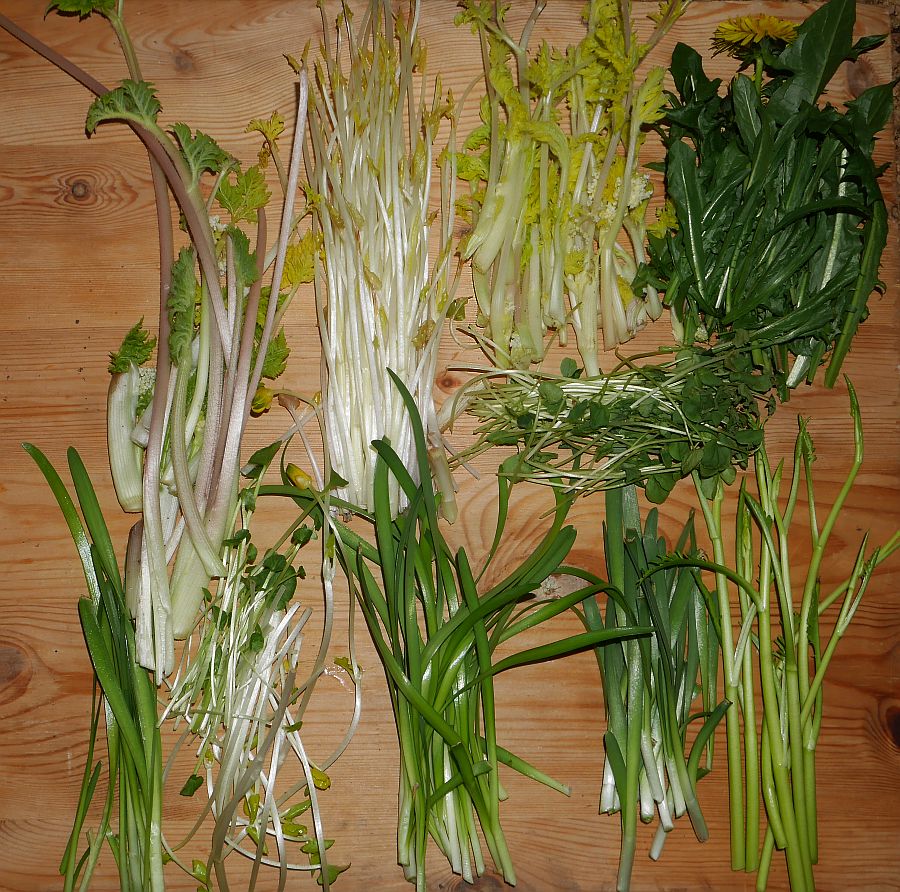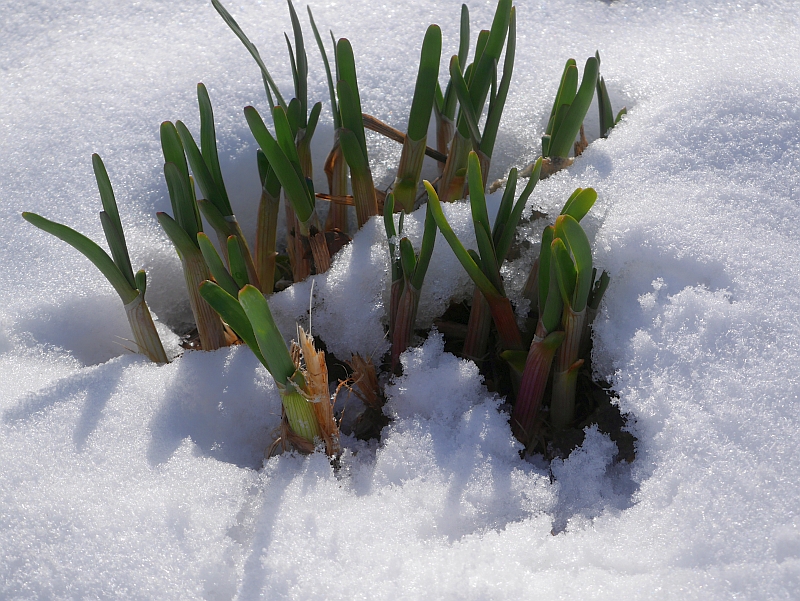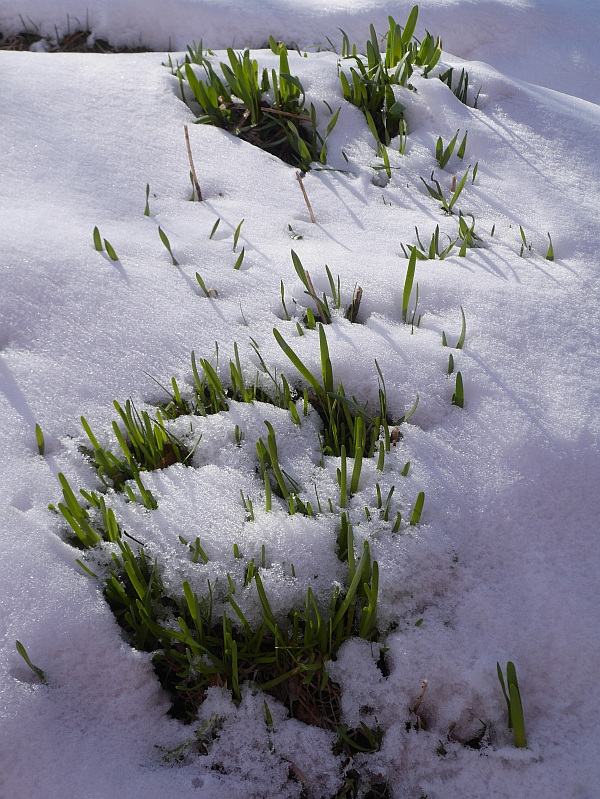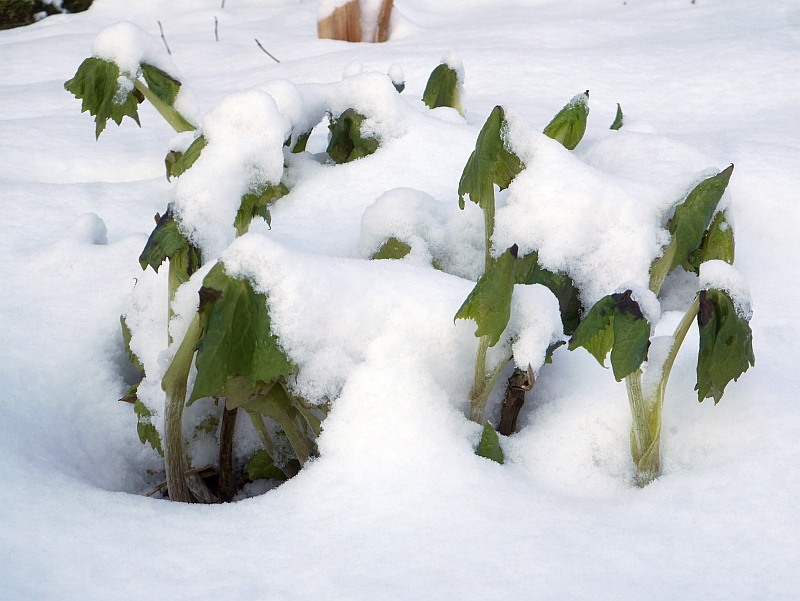Somebody asked me to show how I force veggies indoors in winter, so here you have a link to a short video showing what is available at the moment!
At this time of year, most of our leafy greens used in salads and cooking are either harvested from the forcing pots shown in the video or directly from the cold cellar under the house. Here is a mixture of perennials, biennials and annuals. Still looking for a good perennial chicory for forcing. See the list of plants shown below.
Follow the link to the video.
Witloof Festive Chicory (sikori / julesalat)
Witloof Væres Venner mix (my own selection from the community garden based on several varieties from various gene banks)
Hristo’s onion (Allium flavescens x nutans?)
Kandahar cress (karse) from the Experimental Farm Network (seed harvested in the community garden)
Wild buckwheat / vill bokhvete (seed harvested in The Edible Garden) Garlic bulbil sprouts / spirte hvitløk bulbiller
Nodding onion / prærieløk (Allium cernuum)
Dandelion / løvetann
Tag Archives: Dandelion
Indoor harvest
We’ve been eating dandelions every day this year and now the first batch that I brought up from the cellar is flowering:

 We ate that one yesterday, but there are several more stretching upwards, and the background today is much brighter after a heavy snow fall:
We ate that one yesterday, but there are several more stretching upwards, and the background today is much brighter after a heavy snow fall: …and a bucket of chives can also now be harvested from:
…and a bucket of chives can also now be harvested from:
Wild Enoki, Oca and Hablitzia scrambled eggs
Wild Enoki, Oca, Hablitzia, wild buckwheat sprouts, Allium nutans with dandelion, garlic chilis mixed with scrambled eggs for a delicious home grown and foraged lunch!
Enoki is one of the hardiest fungi appearing often midwinter in mild winters. Also known as velvet shank (vintersopp in Norwegian, meaning winter fungus; Flammulina velutipes). Many had been reporting finding this species recently, and I too found some when I visited the botanical garden the other day! It’s difficult to believe that this is the same fungi as Enokitake or Enoki, sometimes offered in supermarkets and one of the most popular cultivated fungi in the Far East. The cultivated fungi are long and white as they are grown in the dark in an enriched CO2 environment which gives longer stalks.

February salad
Lunch salad had the following ingredients;
From the garden:
Allium scorodoprasum / sand leek / bendelløk (shoots)
Allium cernuum / nodding onion / prærieløk (bulbs and leaves)
Hablitzia tamnoides / Caucasian spinach / stjernemelde (shoots)
From the cellar:
Brassica oleracea / perennial kale / flerårig kål (new leaves)
Cichorium intybus “Witloof” / chicory / sikori (shoots)
Taraxacum spp. /dandelion /løvetann (blanched cellar shoots)
Apium graveolens / celery / selleri (new and old leaves from stored celery plants)
Brassica rapa / turnip / nepe (roots)
Brassica rapa / turnip / nepe (leaf shoots)
Daucus carota / carrot / gulrot
From the living room:
Allium nutans (forced shoots)
Allium sativum / garlic / hvitløk (forced bulbils)
Taraxacum spp. / dandelion / løvetann (forced green leaves)
(served with feta cheese, olive oil, olives, salt and pepper)

Some odds and ends this week in Malvik
- The best of vegetables ready to harvest this week: blanched sea kale (Crambe maritima), blanched lovage (Levisticum officinale) and nettles (Urtica dioica)! Delicious.

-
IT’S DANDINOODLE TIME HERE IN MALVIK: one of the year’s many highlights!This is by far my earliest dandelion to come into growth in March. It was sent to me as seed from the Alps in Switzerland, following a talk I gave there and was supposed to be similar to the moss-leaved dandelion but the leaves weren’t similar at all. These are from one plant! I’m trying to fine out which species it is…

 3. Allium paradoxum var paradoxum isn’t a plant you’ll want in your garden as this form has bulbils which can spread invasively. I was sent this 20 years ago from a garden in Sweden as Allium triquetrum but it wasn’t that one. I never considered either of these invasive Alliums as hardy enough to be a problem here and this one has slowly colonised the space around my oldest Hablitzia tamnoides. With warmer winters I have started more aggressive harvesting of this one.
3. Allium paradoxum var paradoxum isn’t a plant you’ll want in your garden as this form has bulbils which can spread invasively. I was sent this 20 years ago from a garden in Sweden as Allium triquetrum but it wasn’t that one. I never considered either of these invasive Alliums as hardy enough to be a problem here and this one has slowly colonised the space around my oldest Hablitzia tamnoides. With warmer winters I have started more aggressive harvesting of this one. I now harvest both the young leaves, the tops, in particular the bulbils to keep it under control. They are delicious both raw in mixed salads and cooked.
I now harvest both the young leaves, the tops, in particular the bulbils to keep it under control. They are delicious both raw in mixed salads and cooked.
Cellar and Garden Greens: 6th April 2022
The greens that went into last night’s wholegrain spelt quiche are listed below the picture! CELLAR: Dystaenia takesimana shoots; Forced hogweed (bjørnekjeks) shoots (Heracleum spp.); Forced Taraxacum (dandelion / løvetann); nederst til høyre: Witloof chicory (sikkori); øverst til høyre: swiss chard (mangold)
CELLAR: Dystaenia takesimana shoots; Forced hogweed (bjørnekjeks) shoots (Heracleum spp.); Forced Taraxacum (dandelion / løvetann); nederst til høyre: Witloof chicory (sikkori); øverst til høyre: swiss chard (mangold)
GARDEN: Various hybrid onions (Allium senescens x nutans) and Hablitzia tamnoides (Caucasian spinach / stjernemelde)
Snow onions


Various Allium species are the hardiest of edible plants either staying green all winter (e.g., Allium cernuum and Allium carinatum) or sprouting very early and able to withstand some frost. With a minimum forecast of -6C tomorrow after a very mild March, it will be interesting to see whether any of these early shooters are damaged. Here are a selection of pictures of Alliums and other early spring shoots in this weeks snow.
Fasciated dandelion- udo- sea kale salad
Not something I can make very often as I don’t find fasciated dandelions very often! A simple salad was put together, made fascinating with a fasciated dandelion.
The blanched udo (Aralia cordata) was ready: I harvested some blanched sea kale (Crambe maritima) too and I found a fasciated dandelion to decorate the salad
I harvested some blanched sea kale (Crambe maritima) too and I found a fasciated dandelion to decorate the salad
 The udo was peeled
The udo was peeled 
…and the salad was put together with the fasciated dandelion flower stem cut into strips and mixed in with a sesame oil – soya sauce dressing:
Forced March Perennial Greens
In order to lengthen the season for harvesting of perennial vegetables, I dig up roots of a selection in the autumn and plant them in garden soil in large buckets (which I have a surplus of through my Allium project, now moved to the botanical gardens). As I explain in the video, all of these can be stored outside exposed to the cold as they are very hardy (minimum about -20C here), but some get a head start by moving into my cold cellar where they start growing slowly in the dark. Welcome to my living room:
These were the forced veggies used one day last week, from top left and across – Heracleum sibiricum (hogweed / bjørnekjeks); Campanula latifolia (giant bellflower / storklokke); Myrrhis odorata (sweet cicely / spansk kjørvel); Taraxacum officinale (dandelion / løvetann); (bottom row): Allium angulosum; Ficaria verna (lesser celandine / vårkål); Allium flavescens and Armoracia rusticana (horseradish / pepperrot); (centre right): wild buckwheat / vill bokhvete shoots – Fagopyrum tataricum)
25th March Veggies
These delicious fresh perennial vegetables were added tonight’s dal towards the end
Aegopodium podograria (ground elder; skvallerkål)
Allium cernuum (nodding onion; prærieløk)
Brassica oleracea (perennial kale; flerårige kål)
Ficaria verna (lesser celandine; vårkål)
Alliaria petiolata (garlic mustard; løkurt)
Hablitzia tamnoides (Caucasian spinach; stjernemelde)
Taraxacum officinale ( dandelion; løvetann) Forced and blanched in the cellar with flower buds now forming
Myrrhis odorata (sweet cicely; spansk kjørvel)






















